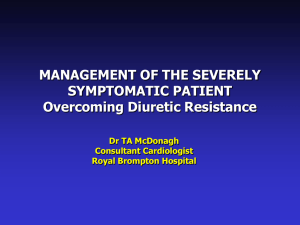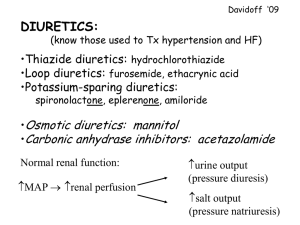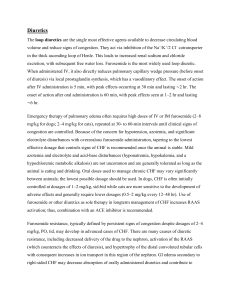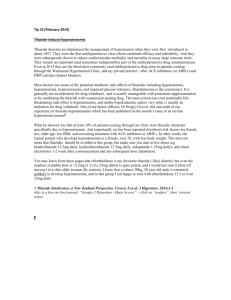Title - BioMed Central
advertisement
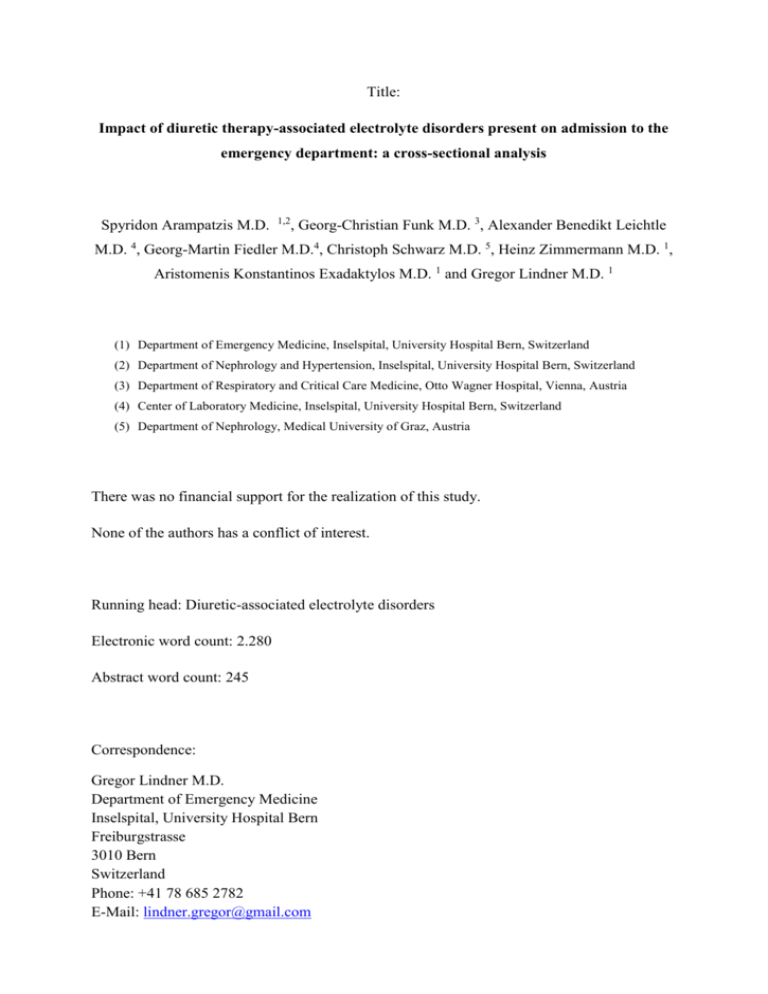
Title: Impact of diuretic therapy-associated electrolyte disorders present on admission to the emergency department: a cross-sectional analysis Spyridon Arampatzis M.D. 1,2 , Georg-Christian Funk M.D. 3, Alexander Benedikt Leichtle M.D. 4, Georg-Martin Fiedler M.D.4, Christoph Schwarz M.D. 5, Heinz Zimmermann M.D. 1, Aristomenis Konstantinos Exadaktylos M.D. 1 and Gregor Lindner M.D. 1 (1) Department of Emergency Medicine, Inselspital, University Hospital Bern, Switzerland (2) Department of Nephrology and Hypertension, Inselspital, University Hospital Bern, Switzerland (3) Department of Respiratory and Critical Care Medicine, Otto Wagner Hospital, Vienna, Austria (4) Center of Laboratory Medicine, Inselspital, University Hospital Bern, Switzerland (5) Department of Nephrology, Medical University of Graz, Austria There was no financial support for the realization of this study. None of the authors has a conflict of interest. Running head: Diuretic-associated electrolyte disorders Electronic word count: 2.280 Abstract word count: 245 Correspondence: Gregor Lindner M.D. Department of Emergency Medicine Inselspital, University Hospital Bern Freiburgstrasse 3010 Bern Switzerland Phone: +41 78 685 2782 E-Mail: lindner.gregor@gmail.com Abstract Backgorund: Diuretics are among the most commonly prescribed medications and, due to their mechanisms of action, electrolyte disorders are common side effects of their use. We investigated the associations between diuretics being taken and the prevalence of electrolyte disorders as well as the impact of electrolyte disorders on patient outcome. Methods: In this cross sectional analysis, all patients presenting between 1 January 2010 and 31 December 2011 to the Emergency Department of the Inselspital, University Hospital Bern, Switzerland were included. Data on diuretic medication, baseline characteristics and laboratory data including electrolytes and renal function parameters were obtained from all patients. A multivariable logistic regression model was performed to assess the impact of factors on electrolyte disorders and patient outcome. Results: 8.5% of patients presenting to the ER used one diuretic, 2.5% two, and 0.4% three or four. 4% had hyponatraemia on admission and 12% hypernatraemia. Hypokalaemia was present in 11% and hyperkalaemia in 4%. All forms of dysnatraemia and dyskalaemia were more common in patients taking diuretics. Loop diuretics were an independent risk factor for all forms of both, while thiazide diuretics were associated with the presence of hyponatraemia and hypokalaemia. In the Cox regression model, all forms of dysnatraemia and dyskalaemia were independent risk factors for in hospital mortality. Conclusions: Existing diuretic treatment on admission to the ER was associated with an increased prevalence of electrolyte disorders. Diuretic therapy itself and disorders of serum sodium and potassium were risk factors for an adverse outcome. Key words: Diuretics, electrolyte disorders, outcome Background Diuretics are a mainstay of therapy for a wide variety of diseases ranging from hypertension to the nephrotic syndrome. Despite this key role, the various substances can have serious side effects, such as volume depletion, ototoxicity as with loop diuretics, and, of course, the induction of electrolyte disorders 1. In an ageing population, the number of patients treated with diuretics for different indications is increasing, as is the relevance of their side effects 2, 3. Studies investigating diuretic therapy-induced electrolyte disorders have mainly focused on the effects of thiazide diuretics. In a randomized controlled trial in hypertensive patients, serum potassium levels were significantly lower in patients treated with thiazide diuretics 4. However, only patients who did not receive potassium supplements developed marked hypokalaemia with potassium levels below 3.0 mmol/L 4 . A more recent study on hypertensive patients found an incidence of 30% for hyponatraemia in patients treated with thiazide diuretics 5. The same study did not find an increased risk of hospitalization or death in patients with thiazide-induced hyponatraemia 5. To our knowledge, the prevalence of diuretic use and associated electrolyte disorders have never been investigated in a large group of patients presenting to a hospital emergency room (ER). Findings from large patient series on the impact of non-thiazide diuretics on electrolyte levels are especially lacking. Thus, we investigated the associations between diuretics being taken and the prevalence of electrolyte disorders as well as the impact of electrolyte disorders on patient outcome. Methods All patients admitted to the ER of the Inselspital, University Hospital Bern, in whom serum sodium was measured between 1 January 2009 and 31 December 2010 were included in this cross-sectional analysis. During the study period, 28,523 serum sodium measurements were made in 22,239 patients. For these 22,239 patients, we gathered data on age, sex, admission type (medical or surgical), country of residence, hospital admission, length of hospital stay, outcome and final diagnosis as classified by the International Classification of Diseases 10 (ICD 10). We also screened the patients’ medications for diuretic use. We gathered information on diuretic use in accordance with the diuretic substances licensed by the Swiss Agency for Therapeutic Products (Swissmedic) as registered in the list of pharmaceutical products (www.kompendium.ch). Diuretic agents combined with other substance classes such as antihypertensive agents were also considered in the analysis. We acquired information on the daily dose of the following substances: hydrochlorothiazide, chlorthalidone, butizide, amiloride, spironolactone, eplerenone, furosemide, torasemide, indapamide, metolazone and acetazolamide. Also, if available, the levels of the following analytes were obtained in the patients with serum sodium measurements: potassium, chloride, calcium, phosphate, magnesium, creatinine and urea. Using the values of these variables, the patients were classed as having an electrolyte disorder or not, based on the reference ranges of our central laboratory (sodium: 135–145 mmol/L, potassium: 3.5–4.7 mmol/L, chloride: 97–108 mmol/L, calcium: 2.1–2.55 mmol/L, phosphate: 0.84–1.45 mmol/L, magnesium: 0.75–1.00 mmol/L). We used baseline characteristics and serum creatinine to calculate the estimated glomerular filtration rate in accordance with the Modified Diet in Renal Disease (MDRD) formula. In the case of multiple admissions, only the first admission to the ER was considered for the analysis. The study was approved by the Ethics Committee of the Canton of Bern, Switzerland. Statistical analysis Data are presented as means ± SD, medians or proportions, as appropriate. Between-group comparisons of continuous variables were performed using the Mann-Whitney U test. Proportions were compared using the χ² test. When the expected count for cells was lower than five, Fisher’s exact test or the exact test module by SPSS was used. Multivariable logistic regression analysis was used to explore the association of the various predictors with the presence of electrolyte disorders and with hospitalisation. Predefined covariates were added to the logistic regression models. The cumulative hazard of death was calculated by the Kaplan-Meier method and the log-rank test was used for comparison of groups. Cox regression was used to test associations of the electrolyte disorders with the survival time adjusted for predefined covariates. A two-sided pvalue < 0.05 was considered statistically significant for all analyses. The statistical analysis was performed using SPSS (SPSS for Windows release 17.0, Chicago, IL). Role of the funding source There was no funding for the realization of this study. Results 22,239 patients with serum sodium measurements were included in the study. The mean age at presentation was 52 years (SD 20) and 57% were men. 76% of patients were Swiss residents. Mean baseline laboratory values are given in Table 1. 19,725 patients (88.7%) had no diuretic agent on admission, while 1,884 (8.5%) had one, 547 (2.5%) had two, and 83 (0.4%) had three or four different diuretic substances as medication (Table 2). Loop diuretics were the most common, with 1,196 patients (48%) on torasemide and 231 (9%) on furosemide. The mean serum sodium and serum chloride concentration were significantly lower in patients on diuretic medication on admission to the ER (138±5 vs 139±4 mmol/L, and 101±8 vs 103±6 mmol/L, p<0.0001). The mean serum potassium level was higher in patients on diuretics (4.03±0.63 vs 3.93±0.45 mmol/L, p<0.0001). Patients on diuretics on admission also had a significantly higher mean serum creatinine concentration (116±97 vs 78±56 µmol/L, p<0.0001). A detailed overview of the comparison between patients with and without diuretic therapy is given in the Appendix of the results section. 845 patients (4% of patients with sodium measurements) had hyponatraemia on admission, 2,630 (12%) hypernatraemia, 246 (11%) hypochloraemia, and 245 (11%) hyperchloraemia. Hypokalaemia was present in 2,459 (11%) and hyperkalaemia was found in 974 (4%). Hypophosphataemia was present in 611 (26%) patients, hyperphosphataemia in 215 (9%), hypomagnesaemia in 1,308 (24%), and hypermagnesaemia in 244 (5%) patients. Hypocalcaemia was found in 956 (12%) and hypercalcaemia in 108 (1%). Hyponatraemia was more common in patients taking diuretic medication (20% vs 7.7%, p<0.0001). The absolute number of different diuretics taken by patients was associated with a higher prevalence of hyponatraemia (p<0.0001). 14% of patients with hyponatraemia were taking loop diuretics, 12% thiazide-type diuretics, 6% aldosterone antagonists, and 1% potassium-sparing diuretics. Hyponatraemia was more likely to be seen in patients taking loop diuretics (OR 1.23), thiazide diuretics (OR 1.48), potassium-sparing diuretics (OR 1.64) and aldosterone antagonists (OR 2.45) than in patients without diuretics (p<0.0001). In the multivariable regression model, use of loop diuretics (OR 1.23, p=0.021), thiazide diuretics (OR 1.48, p<0.0001) and aldosterone antagonists (OR 2.45, p<0.0001) were associated with the presence of hyponatraemia after correction for age, sex and serum creatinine. Hypernatraemia was more common in patients taking diuretic medication (2.2 % vs 1.6%, p=0.03). As with hyponatraemia, the prevalence of hypernatraemia rose with the number of diuretic drugs taken (p=0.02). Loop diuretics were associated with a significantly higher prevalence of hypernatraemia than no diuretic treatment (p=0.0023). There was no significant difference for all other types of diuretic agent (p>0.05). Use of loop diuretics was an independent risk factor for the presence of hypernatraemia after correction for age, sex and serum creatinine levels (OR 1.93, p=0.003). Hypokalaemia was significantly more common in patients under diuretic therapy (17% vs 11%, p<0.0001). In patients taking loop diuretics (p=0.0337), thiazide diuretics (p<0.0001) and potassium-sparing diuretics (p<0.0001), hypokalaemia was more common than in patients on no diuretic therapy. No difference was seen for aldosterone antagonists (p=0.7) or carboanhydrase inhibitors (p=0.9). In the multivariable regression model, loop diuretics (OR 1.3, p=0.014), thiazide diuretics (OR 2.22, p<0.0001) and potassium-sparing diuretics (OR 2.01, p=0.005) were associated with the presence of hypokalaemia. Male sex (OR 0.61, p<0.0001) was also associated with a lower risk for hypokalaemia. Hyperkalaemia was significantly more common in patients on diuretic therapy (13% vs 4%, p<0.0001). The prevalence of hyperkalaemia was linked to the number of diuretic agents taken by patients (p<0.0001). All types of diuretics were associated with an increased prevalence of hyperkalaemia (p<0.05). In the multivariable regression model, loop diuretics (OR 1.44, p=0.002), potassium-sparing diuretics (OR 3.26, p=0.003), aldosterone antagonists (OR 1.87, p<0.0001) and age (OR 1.03, p<0.0001), male sex (OR 1.35, p<0.0001) and serum creatinine (OR 2.23, p<0.0001) were associated with the presence of hyperkalaemia. Thiazide diuretics were associated with a lower risk of hyperkalaemia (OR 0.68, p=0.012). In the multivariable regression model, the presence of hyponatraemia (OR 1.3, p=0.011) and advanced age (OR 1.01, p<0.0001) were associated with a need for hospitalization, while male sex was associated with a lower risk for a need for hospitalization (OR 0.87, p=0.03). Overall, in-hospital mortality was 2.6%. In-hospital mortality of patients with hyponatraemia was 6.8% and was 2.6% for patients with hypernatraemia. Patients with hypokalaemia had an in-hospital mortality of 4.5%, while 10.4% of patients with hyperkalaemia died. Both hyponatraemia (OR 1.46, p=0.004) and hypernatraemia (OR 3.53, p<0.0001) were predictors for increased mortality in the multivariable regression model after correction for age, sex and serum creatinine. The presence of hypokalaemia (OR 1.84, p<0.0001) or hyperkalaemia (OR 2.5, p<0.0001) on admission was also associated with higher mortality in hospital. Figures 1 and 2 show Kaplan-Meier curves for mortality in patients with dysnatraemias and dyskalaemias and for those with normal serum sodium concentrations. Diuretic use and the number of diuretics on admission as well as serum creatinine and age were also associated with increased in-hospital mortality (p<0.0001). Discussion Over a 2-year period, more than 20 thousand patients seen in our ER at a large tertiary care hospital for different reasons had serum sodium measurements, which was the prime variable for inclusion in our study. 11% of these patients were taking diuretic agents, and 3% were taking more than one diuretic agent. Serum sodium levels were significantly lower in patients under diuretic treatment and significantly more patients with hyponatraemia were taking a diuretic on admission. Interestingly, potassium levels were significantly higher in patients under diuretic therapy than in those without diuretics. Hypokalaemia, however, was significantly more often seen in patients on diuretic agents. Loop diuretics were an independent risk factor for all types of sodium and potassium disorders and thiazide-use was associated with the presence of hyponatraemia, hypokalaemia and hyperkalaemia. The use of aldosterone antagonists was an independent risk factor for the presence of hyponatraemia and hyperkalaemia. In a Cox regression model, all forms of dysnatraemia and dyskalaemia were independent risk factors for in-hospital mortality. To our knowledge, this is the first study investigating the associations between all types of diuretic and electrolyte levels in a large group of patients presenting to the ER of a major teaching hospital. Our finding of an association between thiazide diuretic and hyponatraemia and hypokalaemia confirms the results of previous studies 2, 4-7. The association between loop diuretic use and hyponatraemia might be explained by correction of diuretic-induced volume losses by the ingestion of hypotonic fluids. The association between hypernatraemia and loop diuretic use is explained by the mechanism of action of loop diuretics where the excretion of electrolyte-free water exceeds the increased natriuresis 8. Interestingly, all types of diuretics were associated with the presence of hyperkalaemia in our study. A probable explanation for this is that many of the patients taking diuretics were doing so because of renal insufficiency. This is supported by the high mean serum creatinine level of 177 µmol/L in patients with hyperkalaemia. The mechanism of action of aldosterone antagonists explains their association with hyponatraemia and hyperkalaemia in the present study 8. We found that hyponatraemia and hypernatraemia on admission are associated with increased mortality and this supports results from previous studies by our group 9-11 . A recent study in patients with myocardial infarction also found increased mortality in patients with hypokalaemia and hyperkalaemia, supporting our findings on the untoward effects of dyskalaemias on outcome 12. Although our study cannot demonstrate causality, the effects of electrolyte disorders on different physiological functions suggest an independent effect on mortality 13-17. This puts the relevance of diuretic therapy-induced electrolyte disorders into a new light: should patients at risk of developing an electrolyte disorder from a certain diuretic be treated with a different substance? This would be an option, since risk profiles exist at least for thiazide-induced hyponatraemia 18, 19 . A further option would be to more strongly encourage electrolyte supplementation since this appears to be beneficial 4. What at least seems crucial is to create awareness in physicians prescribing diuretic therapy that regular electrolyte monitoring should be performed to identify those who may develop the adverse effects of electrolyte disorders, such as an increased risk of falls or fractures 14, 20. Vasopressin antagonists are the currently newest type of diuretic medication on the market. Today, indications for vasopressin antagonists include eu- and hypervolemic hyponatremia 21. With these new diuretic agents new side effects can be expected: Due to their mechanism of action, namely an inhibition of vasopressin action, overshooting “corrections” of serum sodium could occur. Additionally, hypovolemia and its effects such as dizziness were described in studies on vasopressin antagonists 22. One of the limitations of our study is that it was not practicable to obtain data on and evaluate all medications the patients were taking because of the large number of patients included. Information on other substances that may influence serum electrolytes, such as angiotensinconverting enzyme inhibitors, was not available. We also only had information on the patient’s principal diagnosis, thus excluding secondary diagnoses as potential contributory factors, such as cirrhosis of the liver. One of the strengths of the study, however, was the large number of patients included, and we therefore do not expect that these limitations had a substantial effect on our findings. Conclusion The spectrum of electrolyte disorders in patients on diuretics admitted to our ER varied with the class of diuretic. All diuretics were associated with an increased prevalence of electrolyte disorders on admission. Diuretic therapy itself and disorders of serum sodium and potassium were risk factors for an adverse outcome. Competing interests Financial disclosure The authors declare that they have no competing interests. Authors’ contributions G. Lindner: idea and conception for the study, data gathering and analysis, manuscript draft G.C. Funk: statistical analysis, manuscript draft S. Arampatzis: conception of the study, data analysis A.B. Leichtle: data gathering, statistical analysis G.M. Fiedler: data gathering, statistical analysis, manuscript draft C. Schwarz: data analysis, manuscript draft H. Zimmermann: manuscript draft A.K. Exadaktylos: conception of the study, manuscript draft References 1. Rose BD, Post TW. Clinical use of diuretics. In: Clinical physiology of acid-base and electrolyte disorders. New York: McGraw Hill; 2001:Chapter 15. 2. Mann SJ. The silent epidemic of thiazide-induced hyponatremia. J Clin Hypertens (Greenwich) 2008;10:477-84. 3. Gross P, Palm C. Thiazides: do they kill? Nephrol Dial Transplant 2005;20:2299-301. 4. Siegel D, Hulley SB, Black DM, et al. Diuretics, serum and intracellular electrolyte levels, and ventricular arrhythmias in hypertensive men. JAMA 1992;267:1083-9. 5. Leung AA, Wright A, Pazo V, Karson A, Bates DW. Risk of thiazide-induced hyponatremia in patients with hypertension. Am J Med 2011;124:1064-72. 6. Clayton JA, Rodgers S, Blakey J, Avery A, Hall IP. Thiazide diuretic prescription and electrolyte abnormalities in primary care. Br J Clin Pharmacol 2006;61:87-95. 7. Shapiro DS, Sonnenblick M, Galperin I, Melkonyan L, Munter G. Severe hyponatraemia in elderly hospitalized patients: prevalence, aetiology and outcome. Intern Med J 2010;40:574-80. 8. Rose BD. Clinical Physiology of Acid-Base and Electrolyte Disorders. 5 ed: Mcgraw-Hill; 2001. 9. Funk GC, Lindner G, Druml W, et al. Incidence and prognosis of dysnatremias present on ICU admission. Intensive Care Med 2010;36:304-11. 10. Lindner G, Funk GC, Lassnigg A, et al. Intensive care-acquired hypernatremia after major cardiothoracic surgery is associated with increased mortality. Intensive Care Med;36:1718-23. 11. Lindner G, Funk GC, Schwarz C, et al. Hypernatremia in the critically ill is an independent risk factor for mortality. Am J Kidney Dis 2007;50:952-7. 12. Goyal A, Spertus JA, Gosch K, et al. Serum potassium levels and mortality in acute myocardial infarction. JAMA 2012;307:157-64. 13. Hoorn EJ, Rivadeneira F, van Meurs JB, et al. Mild hyponatremia as a risk factor for fractures: the Rotterdam Study. J Bone Miner Res;26:1822-8. 14. Kinsella S, Moran S, Sullivan MO, Molloy MG, Eustace JA. Hyponatremia independent of osteoporosis is associated with fracture occurrence. Clin J Am Soc Nephrol;5:275-80. 15. Tolouian R, Alhamad T, Farazmand M, Mulla ZD. The correlation of hip fracture and hyponatremia in the elderly. J Nephrol 2011. 16. Lenz K, Gossinger H, Laggner A, Druml W, Grimm G, Schneeweiss B. Influence of hypernatremic-hyperosmolar state on hemodynamics of patients with normal and depressed myocardial function. Crit Care Med 1986;14:913-4. 17. Halperin ML, Kamel KS. Potassium. Lancet 1998;352:135-40. 18. Clark BA, Shannon RP, Rosa RM, Epstein FH. Increased susceptibility to thiazide-induced hyponatremia in the elderly. J Am Soc Nephrol 1994;5:1106-11. 19. Chow KM, Szeto CC, Wong TY, Leung CB, Li PK. Risk factors for thiazide-induced hyponatraemia. QJM 2003;96:911-7. 20. Renneboog B, Musch W, Vandemergel X, Manto MU, Decaux G. Mild chronic hyponatremia is associated with falls, unsteadiness, and attention deficits. Am J Med 2006;119:71 e1-8. 21. Decaux G, Soupart A, Vassart G. Non-peptide arginine-vasopressin antagonists: the vaptans. Lancet 2008;371:1624-32. 22. Schrier RW, Gross P, Gheorghiade M, et al. Tolvaptan, a selective oral vasopressin V2receptor antagonist, for hyponatremia. N Engl J Med 2006;355:2099-112. Table legends Table 1. Baseline laboratory values. All values are mmol/L, except creatinine which is µmol/L and osmolality which is mosm/kg. Table 2. Overview of diuretic substances and dosage. Figure legends Figure 1. Kaplan-Meier curve for mortality in patients with hyponatraemia (OR 1.46, p=0.004) or hypernatraemia (OR 3.53, p=0.0001) versus patients with normal serum sodium. Figure 2. Kaplan-Meier curve for mortality in patients with hypokalaemia (OR 1.84, p<0.0001) or hyperkalaemia (OR 2.5, p<0.0001) versus patients with normal serum sodium. Tables Mean Standard Number of deviation patients (%) Creatinine 82.0 64.0 17,813 (80) Urea 6.4 5.1 15,513 (70) Osmolality 304.0 23.0 3,524 (16) Sodium 139.0 4.0 22,239 (100) Potassium 3.5 0.6 22,165 (99) Chloride 103.0 6.0 2,170 (10) Phosphate 0.6 0.6 2,390 (11) Calcium 2.0 0.2 8,267 (37) Magnesium 0.8 0.1 5,339 (24) Table 1. Baseline laboratory values. All values are mmol/L, except creatinine which is µmol/L and osmolality which is mosm/kg. Diuretic Number of Median dose patients (%) (mg) Torasemide 1.196 (48) 10 Furosemide 231 (9) 40 Hydrochlorothiazide 975 (39) 12.5 Chlorthalidone 102 (4) 12.5 Butizide 16 (1) 2.5 Amiloride 97 (4) 5 Spironolactone 403 (16) 25 Eplerenone 15 (1) 25 Indapamide 58 (2) 1.5 Metolazone 121 (5) 5 Acetazolamide 20 (1) 250 Table 2. Overview of diuretic substances and dosage. Quartile 1 Quartile 3 5 40 12.5 12.5 2.5 2.5 25 25 1.5 2.5 250 20 80 12.5 25 5 5 50 50 1.5 5 500
